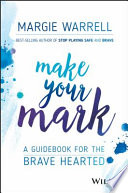

In 'Make Your Mark', one of the central themes is the importance of recognizing and embracing your unique value proposition. The book posits that every individual has distinct skills, experiences, and perspectives that can contribute to their success. This idea encourages readers to introspect and identify what sets them apart from others. By leveraging these unique attributes, individuals can carve out their niche in both personal and professional domains. The author emphasizes that understanding one's unique value is the first step towards building a meaningful brand and achieving long-term success. This concept is particularly relevant in a world that often promotes conformity and standardization. By celebrating individuality, readers are empowered to pursue paths that align with their true selves, leading to more authentic and fulfilling experiences.
Continue readingNetworking is portrayed as an essential tool for personal and professional growth in 'Make Your Mark'. The author illustrates how building and nurturing relationships can open doors to opportunities that might otherwise remain inaccessible. The book provides practical strategies for effective networking, including how to approach potential mentors, the importance of follow-up, and the art of maintaining connections over time. The narrative emphasizes that networking is not just about quantity but the quality of relationships. By fostering genuine connections, individuals can create a support system that aids in their journey, whether it be for job opportunities, collaborations, or personal development. The book also addresses common fears associated with networking, providing encouragement and actionable tips to overcome these barriers.
Continue reading'Make Your Mark' underscores the necessity of continuous learning and adaptability in an ever-changing world. The author argues that the ability to learn new skills and adapt to new situations is crucial for success in any field. This idea is particularly relevant in the context of technological advancements and shifting market dynamics. The book encourages readers to cultivate a growth mindset, where challenges are viewed as opportunities for learning rather than obstacles. Strategies for fostering a learning-oriented approach are provided, including setting personal development goals, seeking feedback, and being open to new experiences. By embracing a culture of continuous learning, individuals can stay relevant and competitive in their careers, ensuring that they can navigate the complexities of their professional landscapes.
Continue readingThe book highlights the significance of setting clear goals and intentions as a foundation for success. The author argues that without a clear direction, individuals may find themselves drifting through their careers and lives without purpose. 'Make Your Mark' provides a framework for effective goal-setting, emphasizing the importance of specificity, measurability, and time-bound objectives. The narrative encourages readers to align their goals with their values and passions, ensuring that their pursuits are meaningful. Additionally, the book discusses the importance of regularly reviewing and adjusting goals to reflect personal growth and changing circumstances. By establishing clear intentions, individuals can create a roadmap for their journeys, leading to greater focus and motivation.
Continue readingResilience is portrayed as a vital trait in 'Make Your Mark', essential for overcoming challenges and setbacks. The author discusses how resilience can be cultivated through mindset shifts, emotional intelligence, and support systems. The book provides insights into the psychological aspects of resilience, including the importance of self-compassion and the ability to reframe negative experiences as learning opportunities. Strategies for building resilience are shared, such as developing coping mechanisms, maintaining a positive outlook, and seeking help when needed. By fostering resilience, individuals can better navigate the inevitable ups and downs of their journeys, emerging stronger and more capable of achieving their goals.
Continue reading'Make Your Mark' emphasizes the importance of taking action despite fear and uncertainty. The author argues that inaction often stems from fear of failure, judgment, or the unknown. The book encourages readers to confront their fears and take calculated risks to pursue their aspirations. It provides practical advice on how to break down daunting tasks into manageable steps, making it easier to take the first leap. Additionally, the narrative explores the concept of 'failing forward', where failures are seen as integral to the learning process. By reframing fear as a natural part of growth, individuals are empowered to take bold steps towards their goals, fostering a proactive approach to their lives.
Continue reading'Make Your Mark' discusses the significance of personal branding in today's competitive landscape. The author explains that a strong personal brand can differentiate individuals in their careers and enhance their visibility. The book outlines the steps to build a personal brand, including identifying core values, crafting a compelling narrative, and utilizing social media effectively. It emphasizes authenticity in branding, encouraging readers to present their true selves rather than a curated image. The narrative also touches on the importance of consistency and engagement in maintaining a personal brand. By strategically developing their personal brands, individuals can enhance their professional opportunities and establish themselves as thought leaders in their fields.
Continue reading